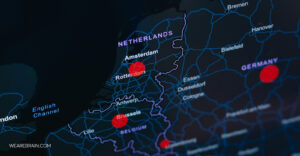How businesses can cut their digital carbon footprint

Did you know that a single internet search consumes roughly 0.3 Wh of energy and contributes to the release of 0.2g of CO2 into the environment? If that doesn’t seem large to you, then perhaps consider there are about 1.74 billion websites currently running on the internet receiving over 4 billion estimated daily visitors, resulting in 2,330,041 tons of CO2 emitted and 2,339,400 MWh of electricity consumed every day. These figures indicate the essential need for a collective drive toward a sustainable digital future.
Unfortunately, many businesses have no clue regarding the number of resources needed to maintain their platforms and servers. Furthermore, they are unaware of the possible ways in which they can reduce their digital footprint to be more sustainable in their operations.
In order to play our part in preserving our planet and to keep the IT industry sustainable in the future, it is time for businesses across the globe, big and small, to go green and reduce their digital footprints.
Why go carbon-neutral?
Apart from the invaluable benefits that reducing our collective CO2 emissions has on helping to preserve the environment and our planet in general, going green also has the power to attract and retain customers.
Today, consumers are far more eco-conscious than ever before and embrace brands and businesses that advocate the concepts of sustainability and clean solutions. Businesses are rapidly responding to customers’ demands to be clean-conscious, and by doing so they are gaining a new generation of sustainably-minded consumers who are keen to advocate brands and offer life-long loyalty to those who follow through on green initiatives.
It’s a win-win situation: companies play their part in ensuring a sustainable world while leveraging this positive initiative to attract new tranches of eco-conscious customers through a relationship built upon trust.
How your business can reduce its digital footprint today
The process of going green can involve a slew of initiatives, from shifting from paper to digital and bookmarking regularly used websites to avoid repeated internet searches, to utilising wind power and reused groundwater to cool servers. But more can be done to reduce your business’s digital footprint.
Website optimisation
You can start decluttering and streamlining your website’s digital assets by removing all unnecessary plug-ins and bulky integrations to reduce load speed and bandwidth usage. You can also resize all large images and videos to the necessary proportions. Using AMPs (accelerated mobile pages) to strip down your web page to display only essential content also helps reduce carbon emissions by being less demanding on bandwidth.
Server-side rendering using CDNs, caching, and Edge Computing can provide extremely fast load speeds to help your customer satisfaction scores big time. This process involves rendering pages on either edge servers or application servers and caching the page: meaning that after the first-page request, all subsequent loads can be handled from the cache, not the server, reducing the amount of energy required.
Server optimisation
The move away from traditional server infrastructure (shared or dedicated) to cloud-based servers has already kick-started the drive toward digital sustainability for many businesses around the world. Traditional servers consume a lot of energy and demand high operational and maintenance costs, and cloud servers are far more energy-efficient and more affordable, in that you only pay for services you need.
You could also explore more suitable hosting, such as virtual private servers (VPS) and green host providers that rent out server platforms to businesses that aim to reduce carbon emissions. These green host providers employ auto-scaling processes which help reduce emissions as well as costs.
Network optimisation
In order to reduce the amount of latency and bandwidth clogging, businesses can decide to place their servers closer in proximity to their users: the closer the server/shorter the distance data needs to travel, the less energy and emissions required. By using local content delivery networks (CDNs), businesses can help reduce network latency and energy demand, all while improving their brand/customer experience by providing fast information.
Businesses can stay close to larger customer-density areas by using CDNs, caching, and Edge Computing to reduce the strain on bandwidth and energy.
Summary
There you have it, our guide to helping your business reduce its digital footprint to play your role in preserving the planet. By incorporating any and all of the above steps and processes, you will be on the road to a greener business that is sustainable for the future.
The best part is that this initiative is a win for everyone: businesses take part in reducing CO2 emissions for a safer, cleaner world, and by doing so they attract a growing number of eco-conscious consumers who will support brands with similar objectives, leading to a better customer experience. The only question remaining is: what are you waiting for?
Mario Grunitz
Working Machines
An executive’s guide to AI and Intelligent Automation. Working Machines takes a look at how the renewed vigour for the development of Artificial Intelligence and Intelligent Automation technology has begun to change how businesses operate.







